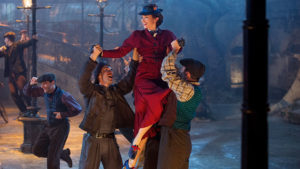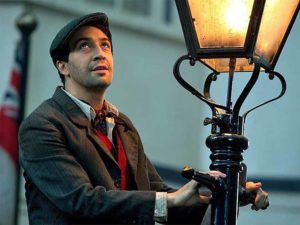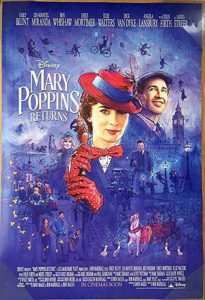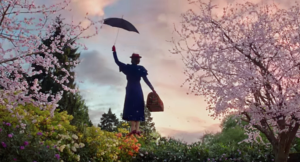
Undoubtedly THE family movie of 2018, Mary Poppins Returns is a joyous, exuberant musical that is banking on a legion of fans of 1964’s Mary Poppins. This is not to say that those young or old, who have never seen the first Poppins, will be lost with this one. However, it would help immensely if they have.
There are grandparents—like yours truly—who did see and greatly enjoy Disney’s first take over 50 years ago. Since then, there have been reissues at theaters, followed by releases on VHS and then DVD formats. Also factor in the numerous times Mary Poppins has been shown as a network TV special. By now, most children have seen it, right? It remains in the same league of beloved family movies as The Wizard of Oz. Come we now to the new Poppins film.
 Touted as a sequel, Mary Poppins Returns is more aptly both a sequel and a re-imagined remake of the 1964 Disney classic. Frankly, there are more similarities than differences. Director/Producer/Co-Story Writer Rob Marshall has fashioned Returns within the same template, including at least three of the same characters. The first film’s house and neighborhood have barely aged, except for the once very young Jane and Michael Banks. They are now adults. Michael (Ben Whishaw) is recently widowed, and has three young kiddos. Sister Jane (Emily Mortimer) has returned to the family home to help Michael and the children deal with their loss.
Touted as a sequel, Mary Poppins Returns is more aptly both a sequel and a re-imagined remake of the 1964 Disney classic. Frankly, there are more similarities than differences. Director/Producer/Co-Story Writer Rob Marshall has fashioned Returns within the same template, including at least three of the same characters. The first film’s house and neighborhood have barely aged, except for the once very young Jane and Michael Banks. They are now adults. Michael (Ben Whishaw) is recently widowed, and has three young kiddos. Sister Jane (Emily Mortimer) has returned to the family home to help Michael and the children deal with their loss.
The elder Mr. and Mrs. Banks of the first movie have evidently died some time ago.
The very bank for which the late Mr. Banks worked, the Fidelity Fiduciary, is now run by the villain of Mary Poppins Returns, William Wilkins (Colin Firth in conniving mode). He has schemed to foreclose on the Banks’ home immediately.
 Enter Mary Poppins, descending from the sky via open umbrella—just as she did in the ’64 movie. But this time she is impressively portrayed by Emily Blunt. Blunt’s singing voice, and she does sing several numbers, is not in Julie Andrews’ league, but it is more than acceptable. Mary then enters the Banks household as a nanny and fixer, intent on winning over the Banks family with words and songs of hope and happiness. She is soon assisted by Jack the lamplighter (Lin-Manuel Miranda), who apprenticed with Bert from the original film. (Bert is nowhere to be seen.)
Enter Mary Poppins, descending from the sky via open umbrella—just as she did in the ’64 movie. But this time she is impressively portrayed by Emily Blunt. Blunt’s singing voice, and she does sing several numbers, is not in Julie Andrews’ league, but it is more than acceptable. Mary then enters the Banks household as a nanny and fixer, intent on winning over the Banks family with words and songs of hope and happiness. She is soon assisted by Jack the lamplighter (Lin-Manuel Miranda), who apprenticed with Bert from the original film. (Bert is nowhere to be seen.)
 As with Mary and Bert in the first flick, Mary and Jack undergo adventures in ultra-colorful live action and animated lands, including an inventive sequence that begins through a bubble bath drain. This is cued by one of the film’s best songs, Can You Imagine That? Other singable songs are “The Place Where Lost Things Go” and “Trip a Little Light Fantastic.” The score also includes snatches of music and songs written by the Sherman Brothers for Mary Poppins.
As with Mary and Bert in the first flick, Mary and Jack undergo adventures in ultra-colorful live action and animated lands, including an inventive sequence that begins through a bubble bath drain. This is cued by one of the film’s best songs, Can You Imagine That? Other singable songs are “The Place Where Lost Things Go” and “Trip a Little Light Fantastic.” The score also includes snatches of music and songs written by the Sherman Brothers for Mary Poppins.
 There are many pluses gained in this new version, including Meryl Streep’s eccentric Topsy, Mary’s orange-haired cousin who frequently turns everything around her upside-down. There is Angela Lansbury’s Balloon Lady, featured in a grand finale. And there is Dick Van Dyke as Mr. Dawes Jr., the bank chairman. (Van Dyke played Dawes Sr. in the original.) The 93 year-old not only sings, but dances…on a desktop.
There are many pluses gained in this new version, including Meryl Streep’s eccentric Topsy, Mary’s orange-haired cousin who frequently turns everything around her upside-down. There is Angela Lansbury’s Balloon Lady, featured in a grand finale. And there is Dick Van Dyke as Mr. Dawes Jr., the bank chairman. (Van Dyke played Dawes Sr. in the original.) The 93 year-old not only sings, but dances…on a desktop.
In addition, Emily Blunt and Lin-Manuel Miranda are practically and perfectly cast.
 David Magee’s screenplay would no doubt be as unacceptable to Mary Poppins author P. L. Travers as she was regarding Don DaGradi and Bill Walsh’s in 1964. She just did not like the addition of singing, dancing, and animation.
David Magee’s screenplay would no doubt be as unacceptable to Mary Poppins author P. L. Travers as she was regarding Don DaGradi and Bill Walsh’s in 1964. She just did not like the addition of singing, dancing, and animation.
Robert and Richard Sherman’s very singable score for the ’64 version is unmatched by Marc Shaiman and Scott Wittman’s 2018 take. Did I leave the theater humming a Mary Poppins Returns song? No. (I did so in 1964.)
Then again, Mary Poppins Returns is brimming with what we need more than ever today: love, hope, and family unity.
——————————
GRADE on an A-F Scale: B+


